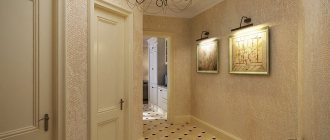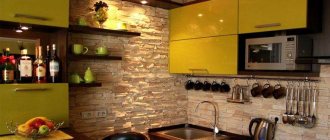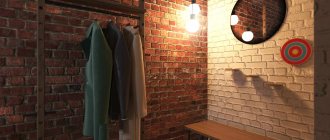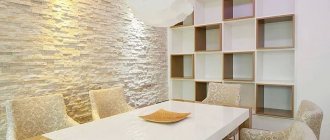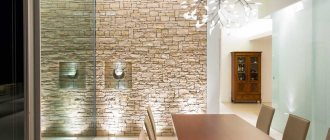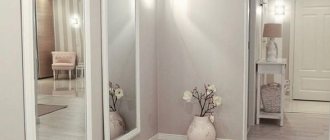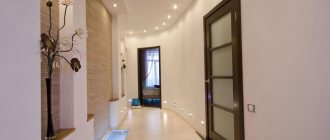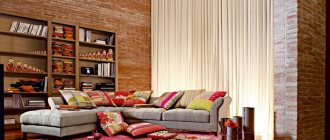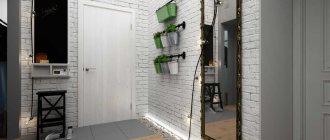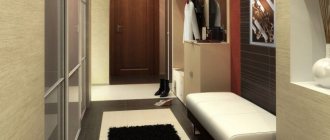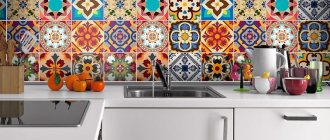Decorative stone in the hallway is a modern solution for decorating a room that can harmoniously fit into almost any interior. You can decorate the corridor yourself, using stone as the main type of covering or an original accent in a separate area. The advantage over natural stone is that artificial stone is much lighter and more affordable from a financial point of view.
Hallway interior with artificial stone Source th.aviarydecor.com
Finishing the arch in the corridor Source stroychik.ru
Decorating the hallway with decorative stone
The walls of the hallway are what catches the eye of any entering guest. Every day the hallway is the very first thing that greets you at home. Therefore, the entrance to the house must have a certain style and be in harmony with the rest of the design of the apartment or house. Which of the many cladding options will be chosen is up to you. We will just reveal a few nuances, knowledge of which will protect you from possible mistakes:
- Often there is not enough natural lighting at the entrance to the apartment. By using materials in warm colors, you will avoid creating a gloomy room.
- Decorating a small corridor with decorative stone and small tiles will visually increase its size. Large elements will visually weigh down an already small space.
- The problem with a wall that has a geometrically complex location can be solved by using flexible stone. The sheets cut and bend well, which makes it possible to cover even rounded corners.
Decorative stone in the house Source catalog6.ru.net/
- Decorative stone is considered a self-sufficient material. You should not add unnecessary decoration (paintings, shelves, photographs) to it. It will be better if the wall remains free.
- The textured surface is highlighted by installing additional vertical lighting. The maximum effect is achieved by using rays propagating from bottom to top.
- You can create an optical illusion and enlarge a small hallway space using the opposite mirror wall.
- The natural warmth of wood will be an excellent complement to the coolness of the stone. Both types of material, when used in the same room, merge into a single harmony.
In warm colors Source krrot.net
Natural stone tiles on the floor Source www.keramis.com.ua
The hallway is the face of the apartment
Many owners do not pay enough attention to the hallway and focus on decorating the living room and kitchen. This is reckless, since acquaintance with the house begins with the appearance of this room. In the case of an apartment, designers consider it the face of the house. Imagine what impression guests will have from the appearance of a room with nondescript decoration and a cluttered floor. It is necessary to create a holistic image of the entire house, and not concentrate on one of the rooms.
The feeling of a holistic design, when one room complements another and is assembled into an ensemble, evokes sympathy for the taste and homeliness of the owner. Decorative elements play a significant role in this. Look at the photo how the designer successfully combines paintings, lighting, and flowers on a shelf to decorate a narrow corridor. Good lighting takes a room to the next level. Nothing spoils the appearance of such a narrow room as a hallway like dim light.
Through the hallway you not only get to the other rooms. This room stores outerwear and shoes, as well as outdoor accessories, strollers, bicycles, scooters, and various products. Its volume is maximally used as a warehouse. The same thing happens with the balcony. Vegetables, bags of cement, etc. are often stored there.
The interior suffers from the fact that the owners choose utilitarianism at the expense of appearance. At the same time, decorating a modern hall is not difficult: it is enough to provide a non-slip floor surface, add beautiful wallpaper or other finishing that serves decorative purposes.
Types of coating
When you see a hallway trimmed with decorative stone, you can’t even imagine what variety of materials can be used for its cladding. Both natural and artificial elements are used. Real stones give the room an original, unique charm; each of them has its own individual texture and coloring. Due to their high cost and heavy weight, they may not always be applicable. In this case, analogues take over.
Stone-effect wallpaper in the hallway Source mebel-go.ru
Outwardly, they are similar to natural materials; it is almost impossible to find differences at a superficial glance. Modern technologies make it possible to create an imitation of any texture and color scheme that can be matched to any style. This becomes the reason for the popularity of such cladding; moreover, the list of materials from which decorative stone is made is impressive:
- Gypsum.
- Cement-sand mixture.
- Agglomerate.
- Granite, marble and quartzite crumbs.
- Porcelain tiles.
- Plastic.
- Flexible sandstone.
Wall decoration: stone imitation Source stenaprofi.ru
Natural stone is most often used for cladding external facades. For interior decoration, it is more practical to use artificial. Conventionally, all materials can be divided into 2 categories: sandstone and decorative tiles.
Stonework in the hallway Source sam-sebe-dizainer.com/ Modern interior Source modernplace.ru
See also: Catalog of companies that specialize in finishing materials.
3. Alignment of walls
First of all, it should be noted that finishing with decorative stone can only be done if the wall is perfectly flat. Otherwise, the wall will be fragile, and it will be very difficult to work on a curved surface. If the difference is more than five millimeters, then using putty you need to correct all the errors that the builders left as a “legacy.” After this, small cracks and small depressions should be carefully rubbed. Close attention should be paid to arches and door openings; cement mortar can be used to seal cracks.
In addition to the wet method of leveling walls (using plaster), there is also a less labor-intensive dry method using plasterboard panels. By the way, you can also hide various communications behind them, and if the corridor is cold, then lay some insulating materials. However, drywall is only compatible with decorative gypsum stone; concrete material requires leveling the wall with plaster, since the partitions will not be able to withstand significant weight.
Finishing with flexible stone in the interior of the hallway
Sandstone is not as famous as gypsum or plastic, but the number of its fans is increasing every year. This is explained by its wide range of applications and amazing results. Used for interior and exterior decoration. It is lightweight and practical, the thickness of the canvas does not exceed 7 mm, consists of three layers:
- Non-woven fabric or flexible fabric base.
- Adhesive (often a solution of epoxy resin is used).
- Fine chips of marble, quartz or granite.
Flexible stone Source hundred-worries.com
Supplied in rolls, tiles or standard slabs 1,000x2,500 mm.
Installation rules
Decorating a hallway with decorative stone of this category is similar to wallpapering. The only condition is to apply glue only to the wall, while the material remains clean. The procedure is as follows:
- The composition is leveled over the working surface with a spatula (thickness, according to the manufacturer’s recommendations).
- A sheet (roll) of flexible stone is applied.
- Corrected in plane and smoothed with a roller.
The process of finishing a wall with flexible stone Source realty.mail.ru
It is fixed using a special glue for flexible stone; if you couldn’t buy one, you can use another one with high adhesive properties.
When installing, follow the rules depending on the type of material used:
- When gluing roll material, start from the corner or extreme point. Move from top to bottom.
- Adjacent strips are glued end to end; choosing the “overlapping” method requires the use of a hair dryer, which heats the edges of the strips. After obtaining a paste-like mass, smooth it with a roller. This achieves a complete, seamless surface.
Hallway with fireplace and sitting area Source roomester.ru
Wall decoration in a modern style Source remoo.ru/
Laying method “Wild stone”
The originality of the method is that the finished surface is similar to a wall built from untreated stone. Laying is carried out similarly to the previously described method. The difference is that at the preparation stage, sheets of decorative stone are cut in the form of large boulders with an irregular geometric shape. This is done with ordinary scissors or a stationery knife.
Partial finishing with stone-like facing tiles for interior work Source nacar.ru
The finished “stones” are distributed on the wall with a deliberate gap of 2-3 mm. Each element is carefully pressed with a roller. After complete drying, the seams are treated with grout. The final step is to apply a water-repellent primer.
Interior in minimalist style Source design-homes.ru
Advantages and disadvantages of flexible stone
Let's reveal the positive and negative aspects of the material. Among the advantages we note:
- Absolute environmental safety. Only natural ingredients that do not have harmful impurities are used in production.
- Easy to maintain and install. The ability to do the work yourself.
- High functionality and versatility. Due to its high elasticity and minimal thickness, flexible stone is successfully used for cladding round and curved surfaces.
- Seamless installation or a wall made of imitation chopped granite – the possibilities for interior design are varied.
- Light weight.
- Not flammable, does not support combustion processes.
- High light transmittance. Sandstone is used to decorate floor and wall lamps.
- Air and vapor permeability, which is favorable for houses made of wood, aerated concrete or other “breathable” materials.
Example of artificial masonry Source www.avito.ru
Texture of flexible stone Source hundred-worries.com
It would take a long time to list the advantages of sandstone stone - we have named only the most significant. Among the shortcomings of the material, pay attention to the following:
- The high price compared to other materials is the main disadvantage of flexible stone. A high-quality coating from a trusted manufacturer will cost 1,500 rubles. per square.
- It is necessary to have a perfectly flat surface “under the wallpaper”. Otherwise, it will not be possible to realize your plans.
- A large amount of uncertified material (counterfeits).
Poor-quality coating does not bend well, can break at bends, does not stick well, and crumbs fall off. Having saved on the purchase, you will be disappointed in the material and will be forced to remodel the hallway.
6.Glue preparation
Pour clean water into a prepared container, gradually add dry powder, kneading thoroughly until smooth. The proportions of water and powder are usually indicated on the packaging. For a uniform consistency and to avoid the formation of lumps, it is better to use a special construction mixer.
When diluting glue, you should not rely on “maybe”; you need to follow the correct ratio of powder and water, which is offered by manufacturers. As a rule, violation of these proportions affects the quality of the entire installation. If the mixture is too liquid, it will reduce the strength of the entire joint; it is difficult to work with a thick composition, and there may simply not be enough glue.
Decorative stone tiles in the hallway
Decorating the hallway with decorative stone is considered a trend of past and future seasons. Natural textures have been and will continue to be popular. This is facilitated by a wide selection of materials.
Arch trimmed with stone Source freepatriot.club
Natural elements
Natural stone tiles can have a textured or smooth surface. In order to increase the effect, varnish or glaze is applied to it. It is distinguished by its high price and heavy weight. Among the models presented on the Russian market, the most popular are those made from the following materials:
- Onyx.
- Marble.
- Granite.
- Basalt.
Other materials are imitation of natural stone with different compositions, characteristics and prices.
Example of wall decoration Source www.geotiles.com
Ceramic tile
Ceramics with imitation of natural stone are one of the most common types used for interior and exterior cladding. It has a huge variety of textures and shades. Capable of displaying the smallest relief elements, transitions and stone veins. Ceramic decorative stone in the hallway can hide imperfections in the form of uneven walls or, on the contrary, focus attention on the merits of the design.
Stone wall Source okoyogurt.com
Successfully used for combined surfaces. It is made under the influence of high temperatures after mixing quartz sand, clay, dyes and binding elements.
Gypsum products
The composition includes a mixture of natural, environmentally friendly gypsum with polymer additives. They are light in weight, resistant to moisture, hygroscopic, susceptible to destruction under mechanical stress, and fragile. They have high heat and sound insulation properties. It is used to cover the entire wall surface or accentuate individual areas: doorways, arches, niches.
Stone-like gypsum tiles in the interior Source www.avito.ru
Clinker
This is a real brick with a thickness of 1-3 cm. Due to its composition and manufacturing process, it can be used indoors and outdoors. It has properties identical to ceramic tiles: good strength, rigidity, resistance to mechanical stress, and is not susceptible to reaction when interacting with household chemicals.
Brick walls Source studiorospis.rf
Porcelain tiles
In terms of performance characteristics, it is practically not inferior to natural stone. It is considered the highest quality analogue in terms of practicality. It has a high wear resistance class with a service life of up to 100 years.
Decorating a hallway in light colors Source www.architonic.com
Conglomerate
It is made from chips of natural stone: marble, onyx, basalt, malachite. The tile is able to imitate most natural minerals. It is rigid, wear-resistant, and not subject to mechanical stress. It is used for cladding walls, hallway floors or other premises.
Marbled stone floor Source sl.aviarydecor.com
Plastic panels
Plastic wall panels for decorative stone decoration of the hallway have low cost and high performance quality. Thanks to these characteristics, the material is popular with consumers. There can be several types:
- Rack and pinion - 2-3 m long, 0.1-0.5 m wide. Mounted according to the tongue-and-groove principle.
- Tile - similar in appearance to ceramic tiles. The size does not exceed 1 m2.
- Sheet - has large dimensions, is mounted without sheathing, using glue.
Modular decorative wall coverings Source xn—-7sbarf4ac3as7a6f.xn--p1ai/
Thanks to a huge selection of materials, it is possible to create an original interior with minimal financial investment.
7.Laying the first row
You need to start laying the stone from the corner. You can choose any angle and move in any direction. In order for the masonry to have support, work is carried out from the bottom up. In the event that it is intended to cover only part of the wall, the area around the arch or door, and not its entire surface, work must begin from any corner of the arch or door. If, based on the sketch, markings are first made on the wall surface, then the work will be much easier. So, installation should begin in the following sequence:
- take a notched trowel and apply a 5 mm layer of adhesive to the first tile;
- place the stone on the wall according to preliminary markings;
- press very tightly and carefully remove excess glue (later it will be extremely difficult to do this);
- fix the second tile nearby;
- If the stone is not laid tightly, but with joints, then you need to carefully observe the required distance.
The entire above process should be repeated until the logical completion of the work. In the case when the entire cladding will consist of stones of different sizes, you need to monitor the sequence of alternation. But if you have previously laid out the rows on the floor, as recommended earlier, then there should be no problems.
Interior ideas
There can be only 2 ways to use stone in the interior of a hallway: veneer the entire wall or a separate part of it. A doorway, arch, corner or other element highlighted with stone will become more expressive. Confirmation of this can be seen in the photo of the best options:
In antique style Source www.zelremstroy.ru/
Cladding of doorways.
Partial decoration of the hallway with artificial stone Source mirkam22.ru/
The chaotic distribution of gypsum tiles makes the room original.
Design of the hallway of the room Source dekordelisi.com
The clinker on the outer and inner corners, near the stairs, performs not only an aesthetic, but also a practical function - it protects the walls from damage (abrasion).
Good hallway lighting Source www.pinterest.com
It is not necessary to emphasize the elements of the walls. Using imitation natural stone, you can focus attention on the mirror and original lighting.
The first option (complete decoration of the hallway walls with decorative stone) will add chic, elegance, and beauty to the room:
Hallway with loft style Source prihozhaya.guru
Corner finishing Source www.houzz.es
Dark long corridor Source www.ornamentalstone.ru/
Stone-like wall in the interior Source 2gis.ru
Original finishing option Source www.casavaga.ru/ Decorative plaster Source www.pinterest.com Beautiful home hallway interior Source www.hros.ru/
11.Sealing joints
The joints that have formed between decorative stones are sealed either with putty or a special compound. To seal joints, it is best to use a construction gun, but, in extreme cases, a thick bag will do. It is necessary to fill with gypsum putty all the existing gaps that have formed between the fragments of the finished masonry. Excess should be removed quickly before this mixture dries.
Since hardened putty usually has a different color from decorative stone, you need to finish sealing the joints by carefully painting them over with paint. The shades of pigments need to be selected as carefully as possible.
Zoning the hallway with decorative stone
The heaviness of the stone is felt not only physically, but also visually. This must be taken into account already at the planning stage. Abuse of material can make the hallway an overly heavy and gloomy room. The only exception is the immediate task of creating the atmosphere of the entrance to a castle or cave. Therefore, it will be enough to zone a certain area.
Wall decor Source www.pinterest.com
An option for partially finishing the hallway with light-colored decorative stone.
Large corridor in the house Source www.archilovers.com
A wall lined with antique stone, with a combination of light colors.
Wall decoration with artificial stone Source yellowhome.ru
Steps imitating layers of rock.
Stone on the wall in the hallway Source prihozhaya.guru
Zoning of the front door, made using the chaotic laying method.
Large mirror in the hallway Source www.dizainvfoto.ru
A positive effect is achieved by edging the mirror. By adding harmonious lighting from a modest room, you will create a solid, expensive hallway.
Decorative wall decoration in the hallway in the loft style Source yellowhome.ru/2019
To create natural coziness, it is enough to zone just one wall.
Artificial stone in a modern interior Source yellowhome.ru/2019
Imitating natural stone on the hallway ceiling is quite a bold decision.
Decoration in white Source prihozhaya.guru
Replacing strict geometric corners with rounded ones and their advantageous zoning.
Laying out the remaining rows
After the first layer has dried, you can begin laying the next row. It is worth noting that some brands of glue dry very quickly, and sometimes work can be continued almost immediately. As you work, do not forget to carefully form all seams horizontally.
Carefully ensure that the entire masonry does not fall to one side or is not in the form of waves. After the next row has been laid, you need to check the strict horizontality of your upper boundaries using a building level. Do not forget to properly remove excess glue, which will inevitably fall on the face of the masonry.
When using a seamless installation method, you must also carefully ensure that the glue fills all the joints at the ends with a thin and even layer. If the stones are quite thick, over 10 millimeters, then there is no need to rush to finish the work quickly and lay out more than four rows of masonry at once. Otherwise, everything may slide due to significant weight. This rule especially applies to concrete stones. You should wait until all the glue has set properly, and only then begin laying the next four rows.
The advantages of decorating the hallway with decorative stone
Decorating the hallway with decorative stone has the following advantages:
- Combines harmoniously with almost any style. Able to fit favorably into the interior of a modern apartment.
- It has a huge range of textures, patterns and color shades.
- Most of the materials used to make decorative stone are classified as environmentally friendly.
- It compares favorably with natural stone in price, weight and ease of installation.
- Not susceptible to infection by fungal parasites.
Decorating the hallway with stone and wallpaper Source www.pinterest.com
The only disadvantage of decorative stone is its shorter service life compared to natural stone. Most manufacturers provide only 10-15 years (depending on the type of material) for the operation of their products.
With proper selection and care, the disadvantage is easily overcome and can last much longer than the period stated by the manufacturer.
Finishing with rough textures Source happymodern.ru/
10.Design of masonry edges
It must be said that the thoroughness of this work is very important, since the entire appearance of the finished masonry will ultimately depend on the accuracy of the completed edges. Stones for the edges of masonry around arches and door openings must be selected more than carefully. The ideal option is to achieve the most minimal stone processing and trimming.
All edges sawn off with a hacksaw or grinder should be sanded with sandpaper and, if necessary, tinted, they should look beautiful and natural. All seams and small chips that have formed on the stones must be carefully repaired and disguised.
Stages of finishing a hallway with decorative stone
The finishing technology depends on the type of material used. One involves fixing to uneven surfaces, the other to carefully leveled ones. For example, flexible stone in the interior of a hallway requires perfectly smooth walls. The use of gypsum and ceramic tiles allows for slight plane deviations. Leveling is done by adding a thickness of glue. Some types of plastic panels are mounted on the sheathing. As a clear example, let’s omit the technology for preparing (leveling) the base and visually consider the stages of cladding with decorative stone:
Laying tiles with glue Source www.hogyan-kell.com/
Natural stone Source stroyday.com
The glue dries within a few minutes, so it is applied in a thin layer. Leveling is carried out with a notched trowel. It is more convenient to start laying from the bottom row.
Having placed the tile against the wall, you need to slightly move it back and forth. This will distribute the adhesive composition over the entire surface.
Laying is carried out end-to-end or with gaps (seams), which will subsequently be treated with contrasting grout. The technique is selected depending on the desired result: to create a smooth surface and straight seams (brickwork), the boundaries of the contours are drawn.
Wall tiling Source bezkovrov.com
To maintain uniform vertical gaps, beacons (crosses) for tiles are used.
Stone tiles in the hallway Source remoo.ru/
Having completed the surface covering, if necessary, treat it with paint or varnish.
At the final stage, distribute the correct lighting. The full effect will be achieved only in this case. For example, 2-3 wall sconces with yellow light will add warmth and comfort to the hallway. Cold, white lighting will add fundamentality and rigor.
Natural stone tiles in the hallway of a private house Source remoo.ru/
Accent wall Source remoo.ru/
4.Primer of walls
When the putty has dried completely and completely, you can prime the surface. Before this, minor roughness on the walls should be eliminated by treating the surface with fine sandpaper. After all the dust has been removed from the corridor, you can coat the walls with two layers of primer. It is better to purchase an acrylic primer.
In the event that only fragmentary cladding is being done, then the allowance left on the wallpaper should also be primed. This work must be done properly; if the wall is poorly primed, the stones may subsequently fall off.
At this point, the pre-preparation process ends, and you can begin laying the facing material directly.
If the corridor has stairs
When decorating such a room, you need to remember that the colors of the walls, floor and stairs must be combined with each other.
Lighting
Lighting fixtures are selected to match the style of the room. For classics, a sconce on the wall is suitable. The Art Nouveau room is decorated with spotlights.
Stylistics of the ladder
This interior element performs not only a functional, but also a decorative task. The style of the staircase should match the design of the house.
Strength of glass materials
The glass staircase does not weigh down the interior, but, on the contrary, gives it lightness and airiness. Transparent steps make the room brighter, and they are made of thick laminated glass.
Advantages of artificial material
Before you make your choice, you should find out all the advantages of finishing with artificial stone:
- Relatively low price.
- Light weight, which reduces the load on wall supports.
- There are no special care or cleaning requirements.
- Does not fade under the influence of sunlight.
- Wide selection of models in color, texture and shape.
This type of decorative stone has earned particular popularity among apartment owners and interior decorators due to the ease of repair work.
